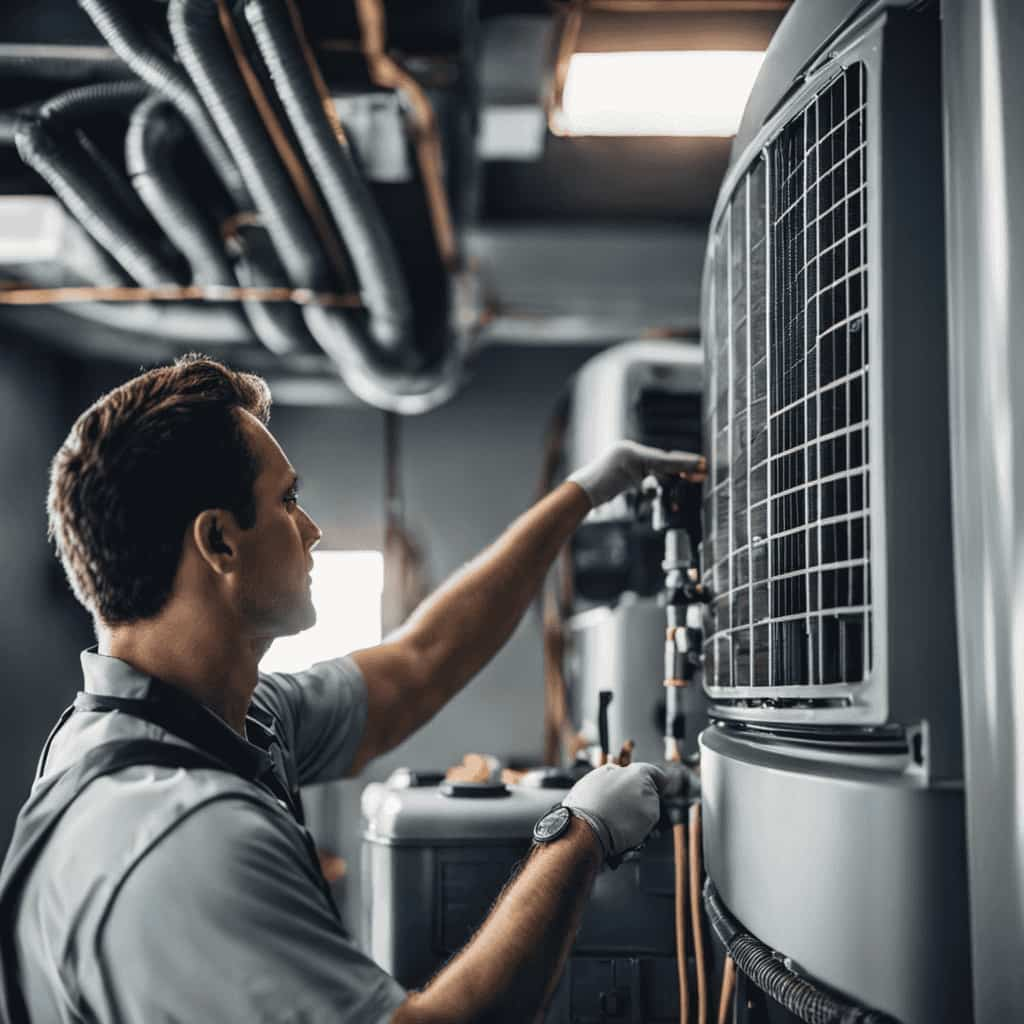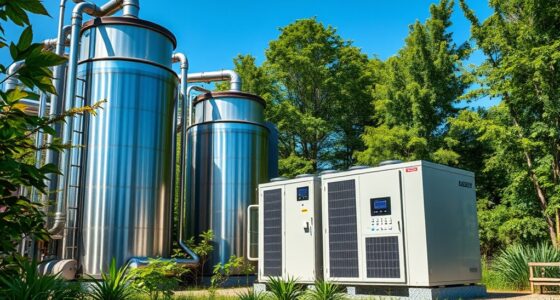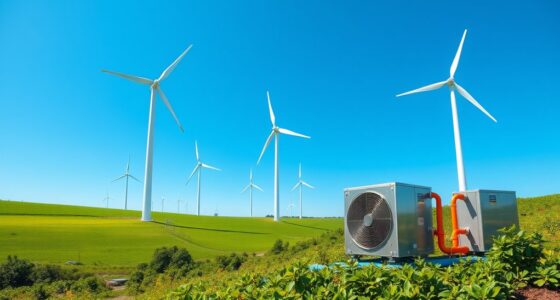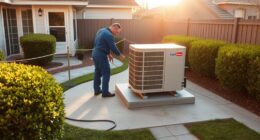Are you prepared to transform your heating setup? Brace yourself to transition to renewable energy heat pumps and become proficient in managing them.
By harnessing the power of renewable resources, we can create a sustainable and efficient way to heat our homes. In this article, we will explore the benefits, costs, and tips for optimizing renewable energy heat pumps.
Join us on this innovative journey towards a greener future. Let’s make a positive impact together.
Key Takeaways
- Renewable energy heat pumps provide significant energy savings compared to traditional heating methods.
- They contribute positively to mitigating climate change and reducing air pollution.
- Regular maintenance is essential for optimal performance of renewable energy heat pumps.
- Government incentives and rebates can help offset the initial costs of switching to renewable energy heat pumps.
Understanding the Benefits of Renewable Energy Heat Pumps
We love the cost savings and environmental benefits of renewable energy heat pumps. These innovative systems are designed to provide efficient heating and cooling solutions while reducing our carbon footprint.

One of the key advantages of renewable energy heat pumps is their ability to maximize performance. By harnessing the natural energy sources such as air, water, or ground, these heat pumps can achieve high levels of efficiency, resulting in significant energy savings.
Additionally, they offer a more sustainable alternative to traditional heating methods, as they don’t rely on fossil fuels and emit fewer greenhouse gases. An environmental impact assessment of renewable energy heat pumps reveals their positive contribution towards mitigating climate change and reducing air pollution.
With their advanced technology and environmental benefits, renewable energy heat pumps are an excellent choice for those seeking innovative and sustainable heating and cooling solutions.
Exploring Different Types of Renewable Energy Heat Pumps
By examining the various types of renewable energy heat pumps, we can gain a better understanding of their unique features and applications. Here are four types of renewable energy heat pumps to consider:
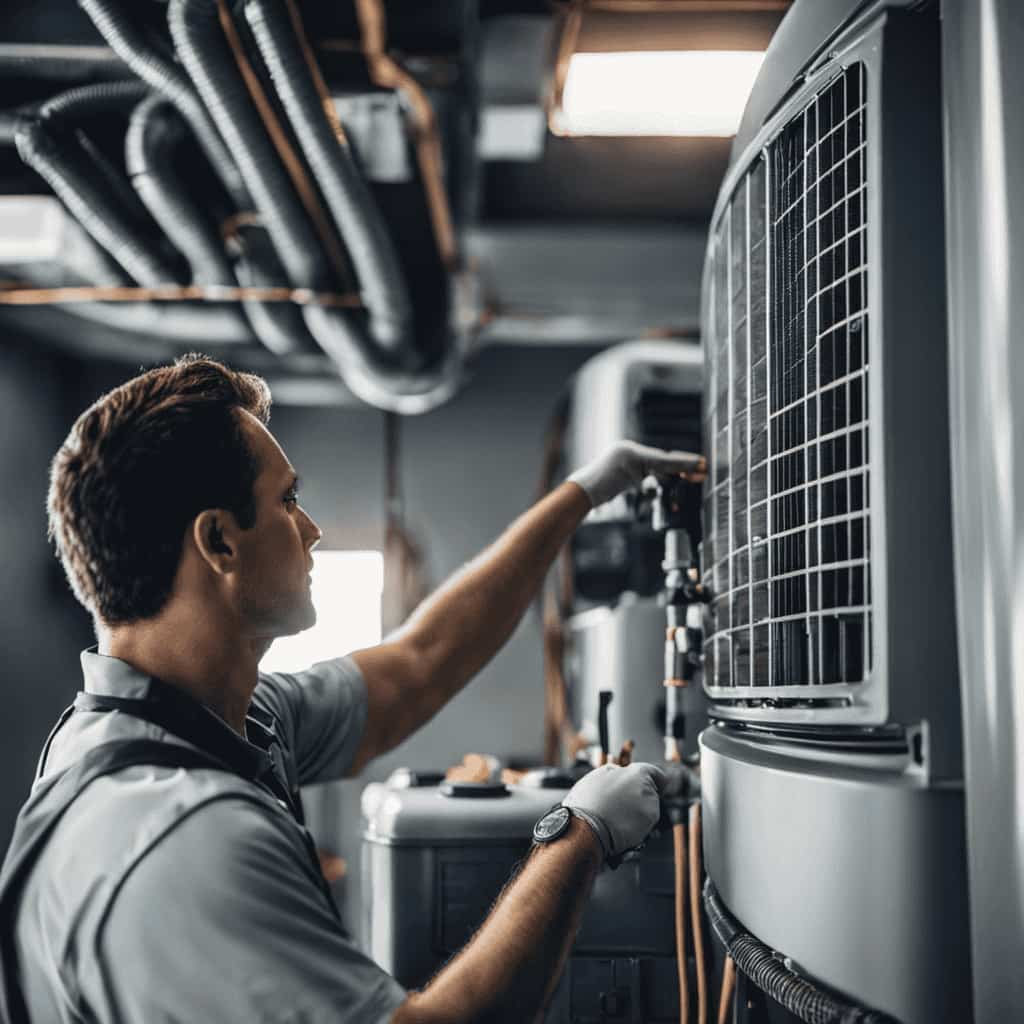
Geothermal Heat Pumps: These pumps utilize the stable temperature of the earth to provide efficient heating and cooling. They extract heat from the ground during winter and transfer heat back into the ground during summer.
Air Source Heat Pumps: These pumps extract heat from the outside air and transfer it into the building during winter. In summer, they remove heat from the indoor air and release it outside. They’re more suitable for regions with moderate climates.
Water Source Heat Pumps: These pumps extract heat from a water source, such as a lake or a well, and distribute it to heat or cool a building. They offer high efficiency and are commonly used in areas near water bodies.
Hybrid Heat Pumps: These pumps combine the efficiency of renewable energy sources, such as geothermal or air source heat pumps, with a traditional fuel source, like natural gas or propane, to provide heating and cooling.

By exploring these different types of renewable energy heat pumps, we can make informed decisions about which system best suits our needs and contributes to a more sustainable future.
Now, let’s move on to evaluating the cost of switching to renewable energy heat pumps.
Evaluating the Cost of Switching to Renewable Energy Heat Pumps
When evaluating the cost of switching to renewable energy heat pumps, there are several key points to consider.
First, the initial investment required for installing a heat pump can vary depending on the size and efficiency of the system.

Second, it’s important to analyze the long-term cost savings that can be achieved through reduced energy consumption and lower utility bills.
Lastly, calculating the return on investment is crucial in determining the financial viability of switching to renewable energy heat pumps.
Initial Investment Considerations
Before making the switch to renewable energy heat pumps, it’s important to carefully evaluate the cost considerations involved. Here are four key factors to consider when conducting a cost analysis for transitioning to renewable energy heat pumps:
Initial Investment: Determine the upfront cost of purchasing and installing the heat pump system, including any necessary modifications to the existing infrastructure.
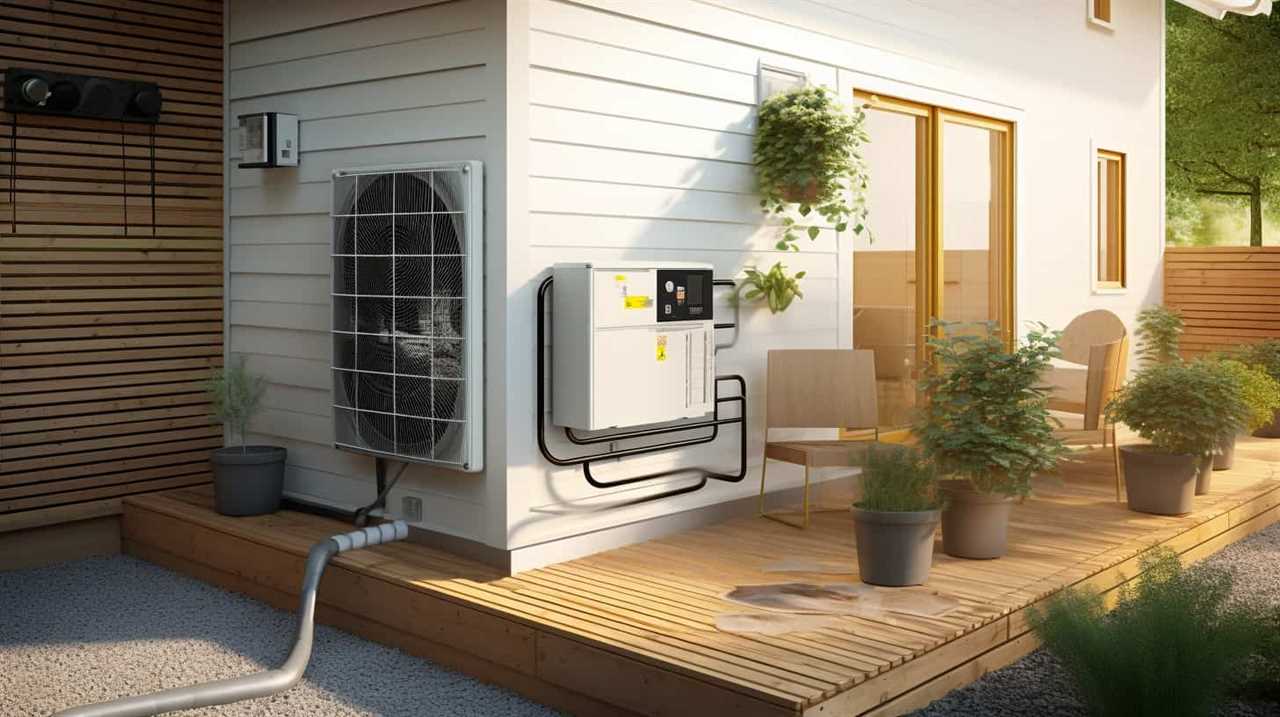
Energy Consumption: Assess the energy consumption of the heat pump system and compare it to your current heating system. Consider the potential savings in energy costs over time.
Operational and Maintenance Costs: Calculate the ongoing operational and maintenance expenses associated with the heat pump system, such as regular servicing and potential repairs.
Incentives and Rebates: Research available incentives and rebates offered by governments and energy providers to offset the initial costs of switching to renewable energy heat pumps.
Long-Term Cost Savings
To accurately assess the long-term cost savings of switching to renewable energy heat pumps, we must consider both the potential reduction in energy expenses and the ongoing operational and maintenance costs.

When evaluating the cost effectiveness of this long term investment, it’s essential to analyze how much energy the heat pump will consume compared to traditional heating systems. Renewable energy heat pumps are designed to be highly efficient, converting energy from natural sources, such as the air or ground, into heat for your home. This increased efficiency can lead to significant reductions in energy consumption and subsequent cost savings over time.
Additionally, it’s important to factor in the ongoing operational and maintenance costs associated with renewable energy heat pumps. While these costs may be slightly higher than traditional heating systems, the long-term savings in energy expenses can outweigh the initial investment, making renewable energy heat pumps a financially viable option for homeowners.
Return on Investment
Considering the potential savings and ongoing costs, we must carefully evaluate the return on investment of switching to renewable energy heat pumps. Conducting a thorough ROI analysis and assessing the financial feasibility is crucial in making an informed decision. Here are four key factors to consider when evaluating the cost-effectiveness of renewable energy heat pumps:
Initial Investment: Calculate the upfront cost of purchasing and installing the heat pump system, including any necessary modifications to the existing infrastructure.
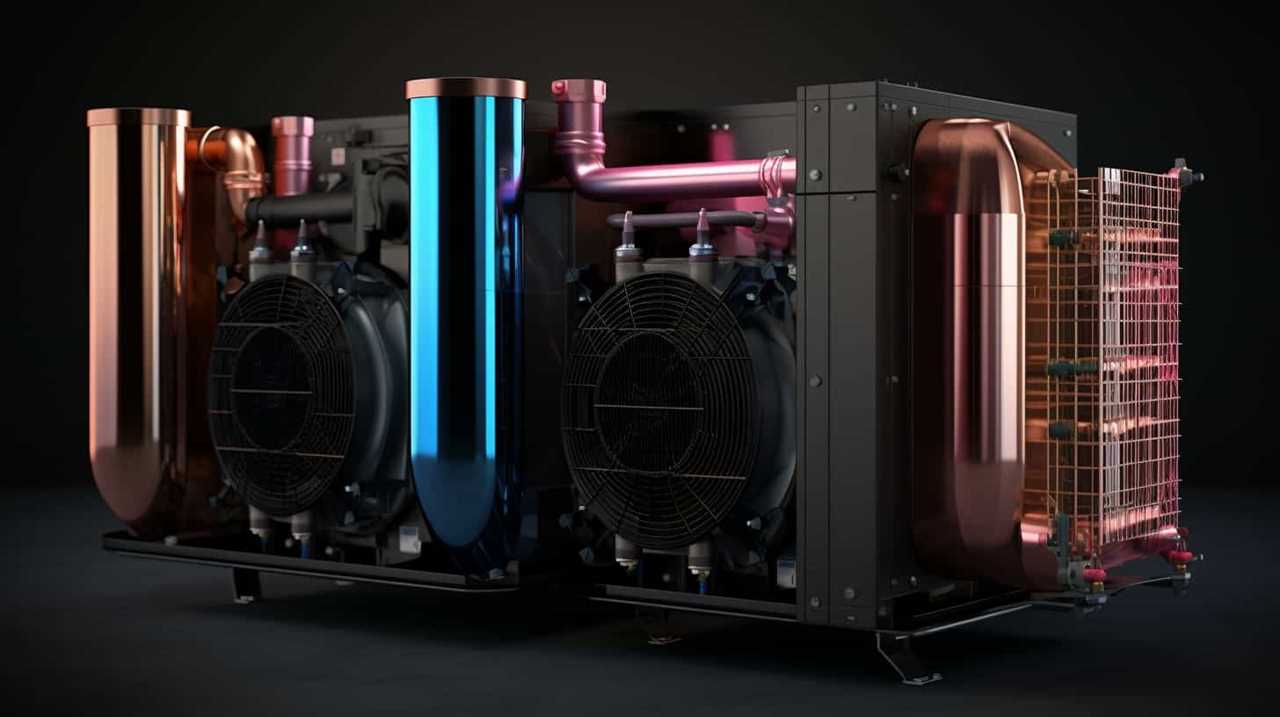
Energy Savings: Determine the potential reduction in energy consumption and associated costs. Consider the efficiency of the heat pump and its ability to provide heating and cooling throughout the year.
Maintenance and Operating Costs: Evaluate the ongoing expenses related to maintaining and operating the heat pump system, including regular servicing and electricity consumption.
Incentives and Financing Options: Explore available incentives, grants, and financing options that can help offset the initial investment and reduce the payback period.
Choosing the Right Size Heat Pump for Your Renewable Energy System
We should carefully assess our heating needs in order to select the proper size heat pump for our renewable energy system. Heat pump sizing is crucial to ensure optimal performance and energy efficiency.

Oversized heat pumps may result in short cycling, where the heat pump turns on and off frequently, leading to increased energy consumption and reduced comfort. Undersized heat pumps, on the other hand, may struggle to meet the heating demands of the space, resulting in inadequate heating and discomfort.
To determine the appropriate size, factors such as the square footage of the area to be heated, insulation levels, climate conditions, and desired indoor temperature should be considered.
It’s recommended to consult with a professional to perform a heat load calculation and recommend the right size heat pump for your renewable energy system.
Maximizing Efficiency: Tips for Optimizing Renewable Energy Heat Pumps
Our goal is to achieve maximum efficiency when optimizing renewable energy heat pumps. To help you in this endeavor, here are four tips to maximize energy and optimize performance:

Proper Sizing: Ensure your heat pump is correctly sized for your heating and cooling needs. Undersized units can lead to inefficiency, while oversized units may cycle on and off frequently, wasting energy.
Regular Maintenance: Schedule regular maintenance to keep your heat pump running at peak performance. This includes cleaning or replacing filters, checking refrigerant levels, and inspecting electrical components.
Optimal Placement: Place your heat pump in a location that allows for efficient airflow and minimizes obstructions. Avoid direct sunlight or areas with excessive noise or vibrations.
Smart Controls: Invest in smart thermostat controls that allow you to program and monitor your heat pump remotely. This enables you to optimize energy usage and adjust settings based on your schedule and preferences.
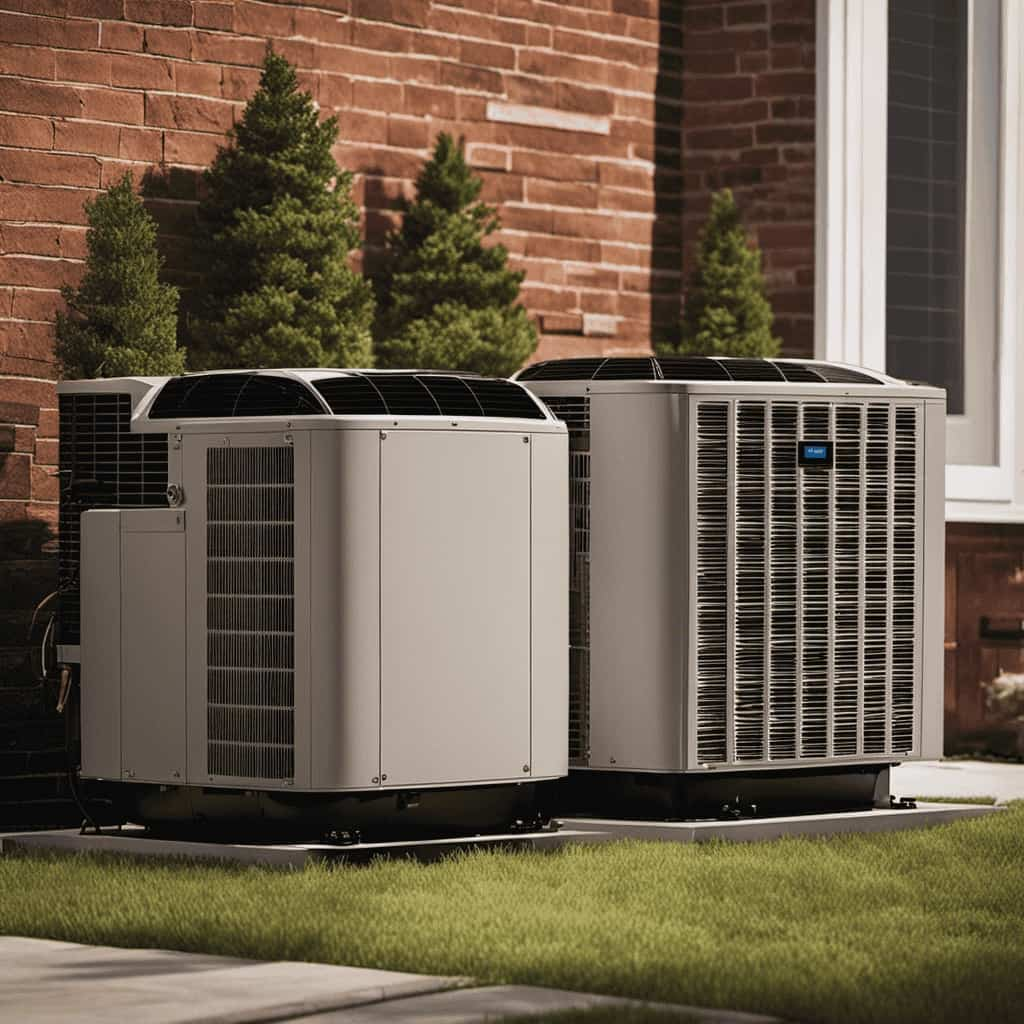
Overcoming Challenges in the Transition to Renewable Energy Heat Pumps
Despite the challenges, we can successfully transition to renewable energy heat pumps by carefully planning and implementing effective strategies.
Overcoming technical challenges is crucial in this transition. One of the main technical challenges is ensuring compatibility between existing heating systems and renewable energy heat pumps. This requires thorough assessment of the infrastructure and making any necessary adjustments or upgrades.
Additionally, addressing consumer concerns is essential. Many consumers worry about the initial cost of installing heat pumps and the reliability of renewable energy sources. To overcome these concerns, it’s important to educate consumers about the long-term cost savings and environmental benefits of renewable energy heat pumps. Providing financial incentives and support programs can also encourage consumers to make the switch.
Government Incentives and Rebates for Renewable Energy Heat Pumps
When considering the switch to renewable energy heat pumps, it’s crucial to understand the financial benefits that government incentives and rebates can offer. These incentives can significantly offset the initial costs of installing a renewable energy heat pump system, making it a more affordable option for homeowners and businesses alike.

Additionally, understanding the eligibility requirements and application process for these incentives is essential to ensure a smooth transition to renewable energy.
Financial Benefits of Incentives
While government incentives and rebates can provide significant financial benefits, it’s important to understand how to maximize these opportunities when transitioning to renewable energy heat pumps. Here are four ways to make the most out of incentive programs and financial incentives:
- Research and Understand Available Programs:
- Take the time to explore the various government incentive programs and rebates that are available in your area.
- Familiarize yourself with the eligibility requirements, application procedures, and any deadlines.
- Calculate Potential Savings:
- Use online calculators or consult with professionals to determine the potential cost savings associated with transitioning to renewable energy heat pumps.
- Consider factors such as reduced energy consumption, lower utility bills, and the long-term return on investment.
- Seek Professional Advice:
- Engage with experts in the field who can guide you through the process of applying for incentives and selecting the right renewable energy heat pump system for your needs.
- They can provide valuable insights and help you make informed decisions.
- Keep Up with Updates:
- Stay informed about any changes or updates to the incentive programs and financial incentives.
- Government policies and programs may evolve over time, so it’s essential to stay up-to-date to take advantage of new opportunities.
Eligibility and Application Process
We should familiarize ourselves with the eligibility requirements and application process for government incentives and rebates when transitioning to renewable energy heat pumps.
In order to qualify for these incentives, homeowners typically need to meet certain criteria, such as having a specific type of heat pump installed, meeting energy efficiency standards, and using a certified installer.

The application process usually involves submitting documentation, such as proof of purchase and installation, energy efficiency ratings, and other relevant information.
It’s important to carefully review the eligibility requirements and application process before proceeding with the installation of a renewable energy heat pump, as this will ensure that homeowners can take full advantage of the available incentives and rebates.
Maintenance and Care: Extending the Lifespan of Renewable Energy Heat Pumps
To ensure optimal performance and longevity, we should regularly and diligently maintain and care for our renewable energy heat pumps. These innovative devices require proper maintenance to extend their lifespan and maximize their efficiency.
Here are four essential maintenance and care practices for renewable energy heat pumps:
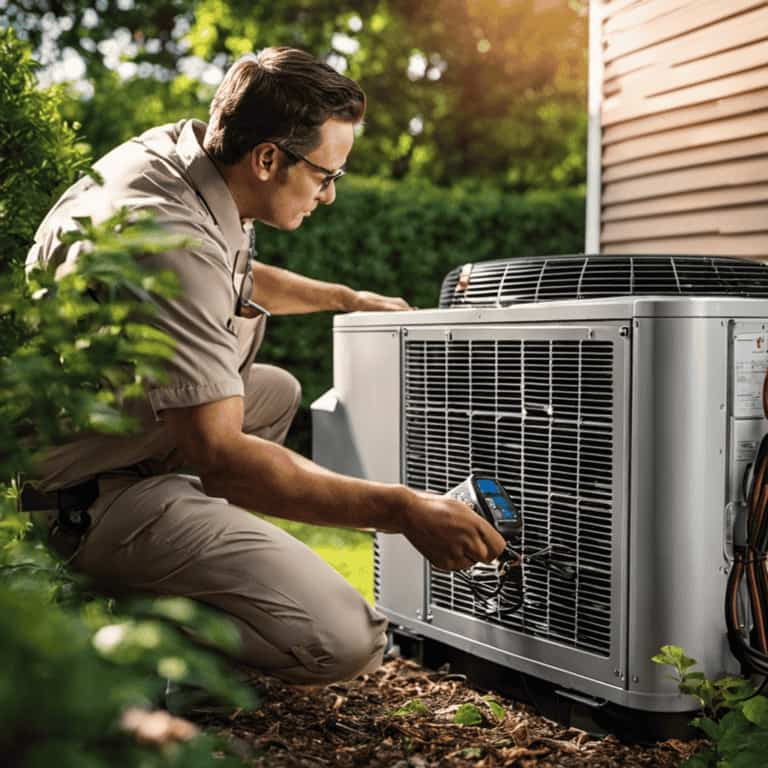
Regularly clean and replace air filters: Clogged air filters can reduce airflow and strain the system, leading to decreased performance and increased energy consumption.
Inspect and clean outdoor coils: Dirt and debris can accumulate on the outdoor coils, hindering heat transfer and reducing the pump’s efficiency. Regular cleaning can prevent this issue.
Check and tighten electrical connections: Loose connections can lead to system failures and safety hazards. Regularly inspect and tighten electrical connections to ensure proper functioning.
Schedule professional maintenance: Regular maintenance by certified technicians can identify and address any potential issues before they become major problems, increasing the lifespan of the heat pump.

The Role of Smart Technology in Renewable Energy Heat Pump Systems
Smart technology plays a crucial role in optimizing the performance of renewable energy heat pump systems. By utilizing advanced algorithms and sensors, smart technology can improve the overall efficiency of these systems, resulting in reduced energy consumption and lower carbon emissions.
Additionally, the integration of smart technology with existing heating and cooling systems allows for seamless control and monitoring, enhancing user experience and enabling better energy management.
Furthermore, the implementation of smart technology in renewable energy heat pump systems has the potential to generate significant cost savings over time through improved energy efficiency and optimized operation.
Efficiency of Smart Technology
In our current era, the efficiency of smart technology plays a crucial role in optimizing renewable energy heat pump systems. Smart technology benefits these systems by improving energy efficiency through various means:

Advanced controls: Smart technology allows for precise control over the heating and cooling process, optimizing energy usage based on real-time data. This ensures that energy is used only when needed, reducing waste.
Remote monitoring and optimization: Smart technology enables remote monitoring and control of heat pump systems, allowing for real-time adjustments and optimizations. This ensures that the system operates at its peak efficiency, even when no one is present at the location.
Integration with renewable energy sources: Smart technology can seamlessly integrate renewable energy sources, such as solar panels or wind turbines, with heat pump systems. This allows for the utilization of clean, sustainable energy, further reducing carbon footprint.
Data-driven insights: Smart technology provides valuable data and insights into energy usage patterns and system performance. This enables users to make informed decisions and adjustments to further improve energy efficiency.

Integration With Existing Systems
As we transition to renewable energy heat pump systems, it is essential to consider how smart technology can integrate with existing systems to optimize efficiency. Integrating smart technology with renewable energy heat pumps can help overcome integration challenges and provide retrofitting options for existing systems.
| Integration Challenges | Retrofitting Options |
|---|---|
| Compatibility with existing systems | Use of adapters and converters to connect smart technology with existing systems |
| Communication protocols | Implementing open standards and protocols for seamless communication between smart technology and existing systems |
| Data management | Utilizing cloud-based platforms and data analytics to efficiently manage and analyze data from both smart technology and existing systems |
| User interface | Developing user-friendly interfaces that allow easy control and monitoring of both smart technology and existing systems |
Cost Savings Potential
By utilizing smart technology in our renewable energy heat pump systems, we can maximize our cost savings potential. Smart technology allows for more efficient control and optimization of the heat pump system, resulting in significant energy savings and reduced costs. Here are four ways in which smart technology enhances the cost savings potential of renewable energy heat pump systems:
Energy monitoring and optimization: Smart technology enables real-time monitoring and analysis of energy consumption, allowing for precise control and optimization of the heat pump system’s performance. This leads to higher energy efficiency and lower operating costs.
Demand response capabilities: Smart heat pump systems can respond to signals from the electricity grid, adjusting their operation to take advantage of off-peak electricity rates. This helps to further reduce energy costs by utilizing electricity when it’s cheaper and more abundant.

Remote control and monitoring: With smart technology, heat pump systems can be controlled and monitored remotely through mobile apps or web interfaces. This allows for easy adjustment of settings and monitoring of energy usage, enabling users to make informed decisions to optimize energy efficiency and cost savings.
Integration with renewable energy sources: Smart heat pump systems can integrate with other renewable energy sources such as solar panels or wind turbines. By intelligently managing the energy flow between different sources and the heat pump, smart technology maximizes the utilization of renewable energy, reducing reliance on grid electricity and minimizing the environmental impact.
Case Studies: Successful Transitions to Renewable Energy Heat Pumps
We have observed successful transitions to renewable energy heat pumps in various case studies. These case studies highlight the benefits of transitioning to renewable energy heat pumps, such as cost savings, increased energy efficiency, and reduced carbon emissions.
One case study examined a residential building in a cold climate that replaced its traditional heating system with a ground source heat pump. The transition resulted in a 40% reduction in energy consumption and annual cost savings of over $1,500.

Another case study focused on a commercial building that switched to an air source heat pump, resulting in a 50% reduction in energy costs and a significant decrease in greenhouse gas emissions.
These successful transitions demonstrate the potential for renewable energy heat pumps to provide both financial and environmental benefits.
Planning for the Future: Scaling Up Renewable Energy Heat Pump Systems
To ensure widespread adoption of renewable energy heat pump systems, it’s crucial that we develop comprehensive plans for scaling up their implementation in various sectors. By planning for the future and considering the following strategies, we can maximize the performance of renewable energy heat pump systems and pave the way for future advancements:
Infrastructure Development: Investing in the necessary infrastructure, such as grid upgrades and distribution networks, will support the widespread deployment of renewable energy heat pump systems.

Policy Support: Implementing supportive policies, including financial incentives and regulations, will encourage the adoption of renewable energy heat pump systems and create a favorable market environment.
Research and Development: Investing in research and development will enable us to continuously improve the performance and efficiency of renewable energy heat pump systems, driving innovation and cost reductions.
Collaboration and Knowledge Sharing: Fostering collaboration and knowledge sharing among industry stakeholders, researchers, and policymakers will help accelerate the transition to renewable energy heat pump systems by sharing best practices and lessons learned.
Frequently Asked Questions
Are Renewable Energy Heat Pumps Suitable for All Types of Homes and Buildings?
Renewable energy heat pumps can be suitable for most homes and buildings. Installation suitability depends on factors such as available space and heat demand. They offer high energy efficiency and are a promising solution for transitioning to sustainable heating systems.

How Long Does It Typically Take to Recoup the Cost of Switching to Renewable Energy Heat Pumps?
Cost savings and energy efficiency are key factors in recouping the cost of switching to renewable energy heat pumps. It typically takes a few years to see a return on investment, but the long-term benefits are worth it.
Can Renewable Energy Heat Pumps Be Used for Both Heating and Cooling Purposes?
Yes, renewable energy heat pumps can be used for both heating and cooling purposes. They offer high heating efficiency and cooling efficiency, making them a versatile and innovative solution for individuals seeking to switch to renewable energy.
Are There Any Specific Maintenance Requirements for Renewable Energy Heat Pumps?
When it comes to maintenance requirements for renewable energy heat pumps, there are a few key things to keep in mind. Regular inspections, cleaning filters, and troubleshooting tips can all help ensure optimal performance and longevity.
What Are the Potential Environmental Impacts of Renewable Energy Heat Pumps?
The potential environmental impacts of renewable energy heat pumps include reduced carbon emissions, improved air quality, and decreased reliance on fossil fuels. Additionally, government incentives and potential economic benefits make them an attractive option for sustainable heating and cooling.

What Are the Benefits of Geothermal Heat Pumps for Switching to Renewable Energy?
Geothermal heat pumps utilize the earth’s natural heat to provide heating and cooling for residential and commercial spaces. Mastering geothermal heat pumps for renewable energy brings significant benefits. Firstly, they are highly efficient, reducing energy consumption and resulting in lower utility bills. Secondly, they have a smaller carbon footprint, thus minimizing greenhouse gas emissions. Lastly, by utilizing renewable energy, geothermal heat pumps contribute to a sustainable future.
Conclusion
In conclusion, transitioning to renewable energy heat pumps offers numerous benefits, including reduced carbon emissions and lower energy costs. By exploring different types of heat pumps and evaluating the cost of switching, individuals can make informed decisions about their renewable energy systems.
Maximizing efficiency and implementing smart technology can further optimize heat pump performance. Through proper maintenance and care, the lifespan of renewable energy heat pumps can be extended.
Successful case studies demonstrate the feasibility and effectiveness of this transition, while planning for the future involves scaling up these systems to meet increasing demand.
To sum up, renewable energy heat pumps are a viable and sustainable solution for heating and cooling needs.
